Page 462 of 543
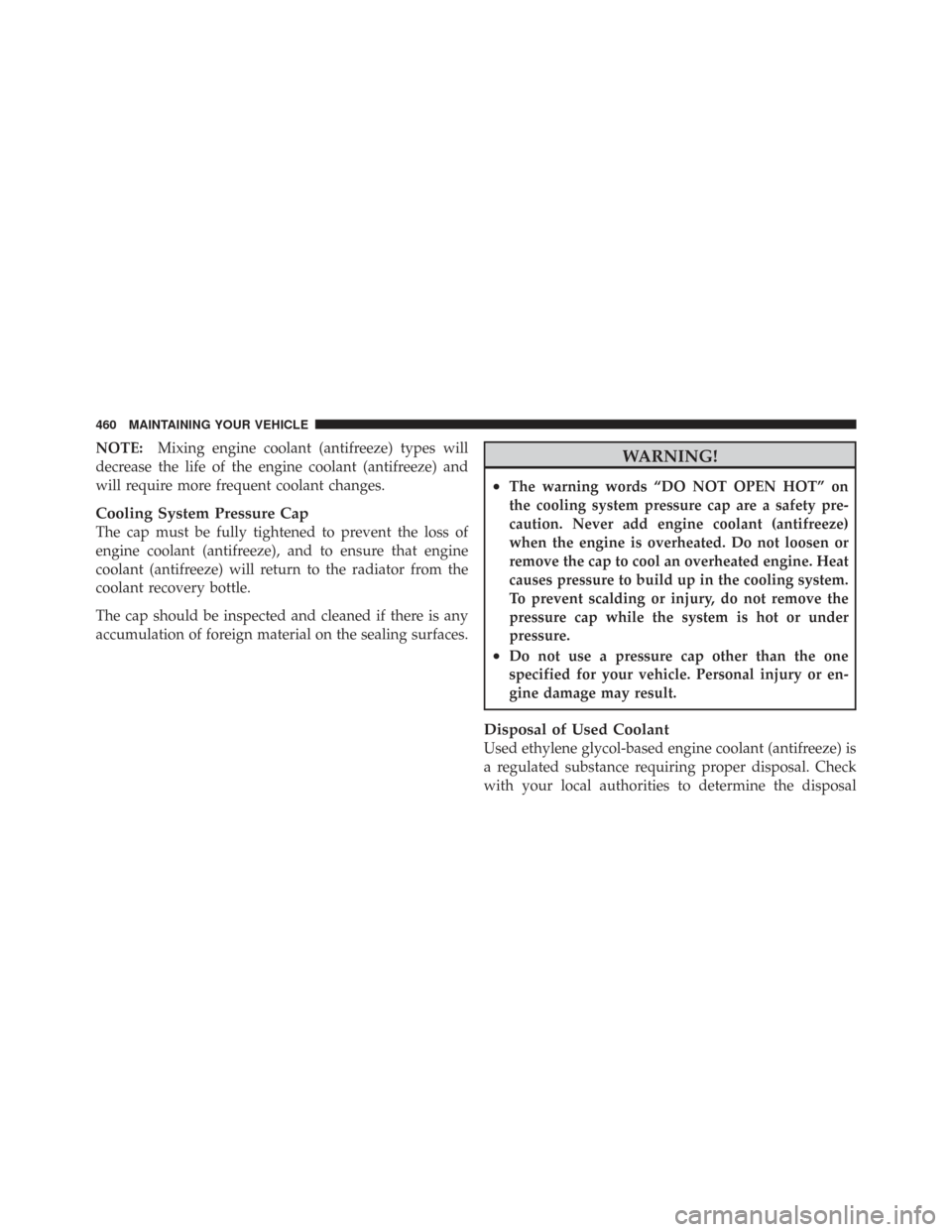
NOTE:Mixing engine coolant (antifreeze) types will
decrease the life of the engine coolant (antifreeze) and
will require more frequent coolant changes.
Cooling System Pressure Cap
The cap must be fully tightened to prevent the loss of
engine coolant (antifreeze), and to ensure that engine
coolant (antifreeze) will return to the radiator from the
coolant recovery bottle.
The cap should be inspected and cleaned if there is any
accumulation of foreign material on the sealing surfaces.
WARNING!
•The warning words “DO NOT OPEN HOT” on
the cooling system pressure cap are a safety pre-
caution. Never add engine coolant (antifreeze)
when the engine is overheated. Do not loosen or
remove the cap to cool an overheated engine. Heat
causes pressure to build up in the cooling system.
To prevent scalding or injury, do not remove the
pressure cap while the system is hot or under
pressure.
•Do not use a pressure cap other than the one
specified for your vehicle. Personal injury or en-
gine damage may result.
Disposal of Used Coolant
Used ethylene glycol-based engine coolant (antifreeze) is
a regulated substance requiring proper disposal. Check
with your local authorities to determine the disposal
460 MAINTAINING YOUR VEHICLE
Page 463 of 543
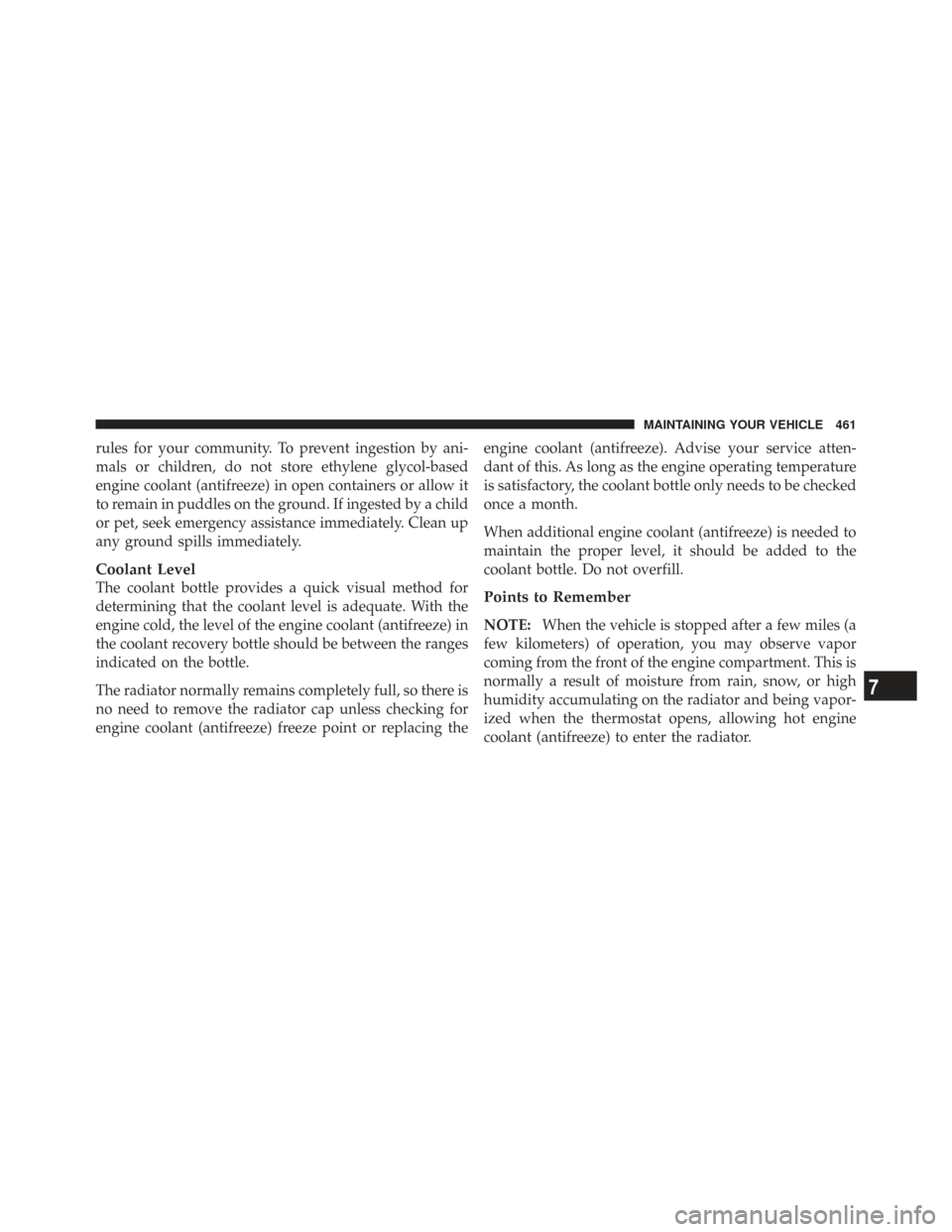
rules for your community. To prevent ingestion by ani-
mals or children, do not store ethylene glycol-based
engine coolant (antifreeze) in open containers or allow it
to remain in puddles on the ground. If ingested by a child
or pet, seek emergency assistance immediately. Clean up
any ground spills immediately.
Coolant Level
The coolant bottle provides a quick visual method for
determining that the coolant level is adequate. With the
engine cold, the level of the engine coolant (antifreeze) in
the coolant recovery bottle should be between the ranges
indicated on the bottle.
The radiator normally remains completely full, so there is
no need to remove the radiator cap unless checking for
engine coolant (antifreeze) freeze point or replacing theengine coolant (antifreeze). Advise your service atten-
dant of this. As long as the engine operating temperature
is satisfactory, the coolant bottle only needs to be checked
once a month.
When additional engine coolant (antifreeze) is needed to
maintain the proper level, it should be added to the
coolant bottle. Do not overfill.Points to Remember
NOTE:
When the vehicle is stopped after a few miles (a
few kilometers) of operation, you may observe vapor
coming from the front of the engine compartment. This is
normally a result of moisture from rain, snow, or high
humidity accumulating on the radiator and being vapor-
ized when the thermostat opens, allowing hot engine
coolant (antifreeze) to enter the radiator.
7
MAINTAINING YOUR VEHICLE 461
Page 464 of 543
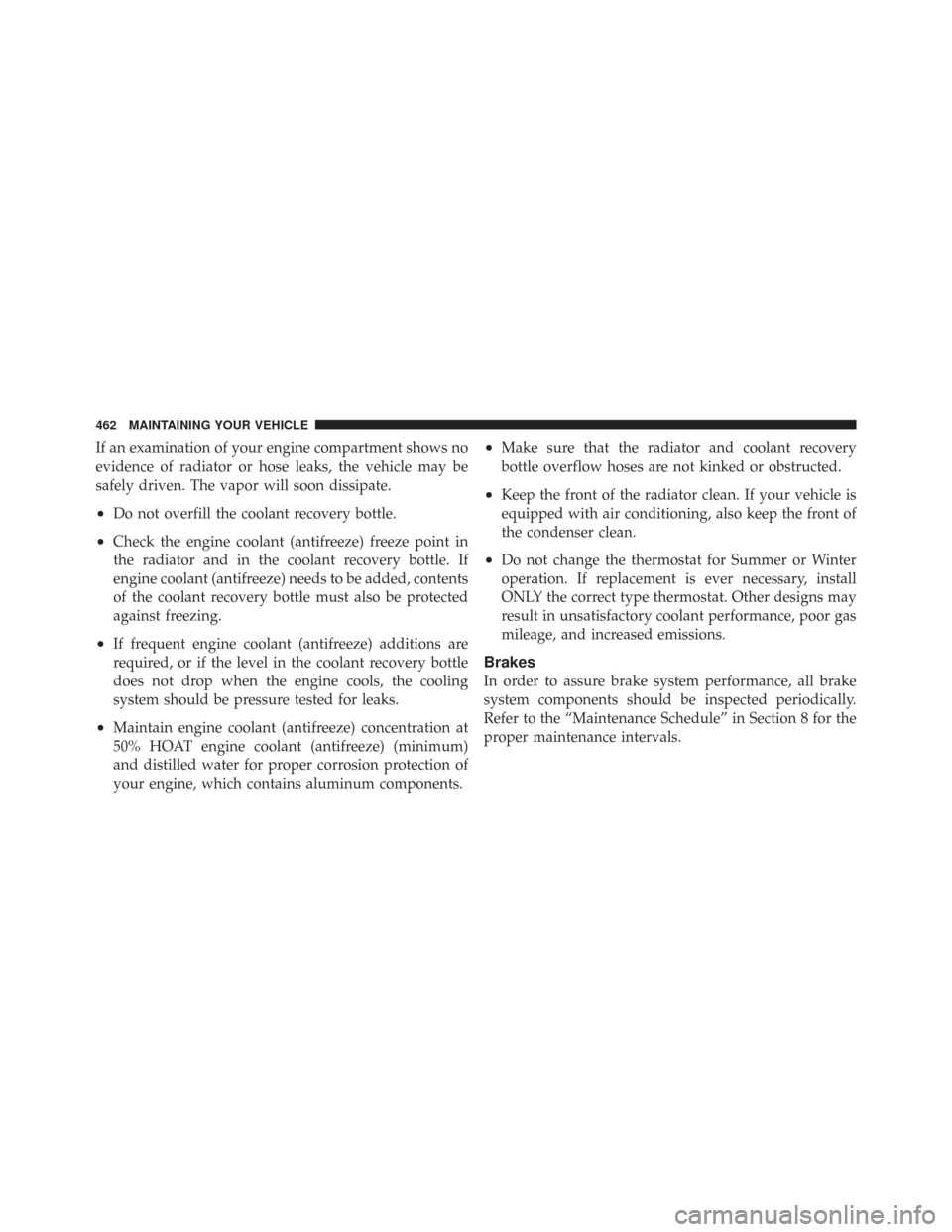
If an examination of your engine compartment shows no
evidence of radiator or hose leaks, the vehicle may be
safely driven. The vapor will soon dissipate.
•Do not overfill the coolant recovery bottle.
•Check the engine coolant (antifreeze) freeze point in
the radiator and in the coolant recovery bottle. If
engine coolant (antifreeze) needs to be added, contents
of the coolant recovery bottle must also be protected
against freezing.
•If frequent engine coolant (antifreeze) additions are
required, or if the level in the coolant recovery bottle
does not drop when the engine cools, the cooling
system should be pressure tested for leaks.
•Maintain engine coolant (antifreeze) concentration at
50% HOAT engine coolant (antifreeze) (minimum)
and distilled water for proper corrosion protection of
your engine, which contains aluminum components.
•Make sure that the radiator and coolant recovery
bottle overflow hoses are not kinked or obstructed.
•Keep the front of the radiator clean. If your vehicle is
equipped with air conditioning, also keep the front of
the condenser clean.
•Do not change the thermostat for Summer or Winter
operation. If replacement is ever necessary, install
ONLY the correct type thermostat. Other designs may
result in unsatisfactory coolant performance, poor gas
mileage, and increased emissions.
Brakes
In order to assure brake system performance, all brake
system components should be inspected periodically.
Refer to the “Maintenance Schedule” in Section 8 for the
proper maintenance intervals.
462 MAINTAINING YOUR VEHICLE
Page 466 of 543
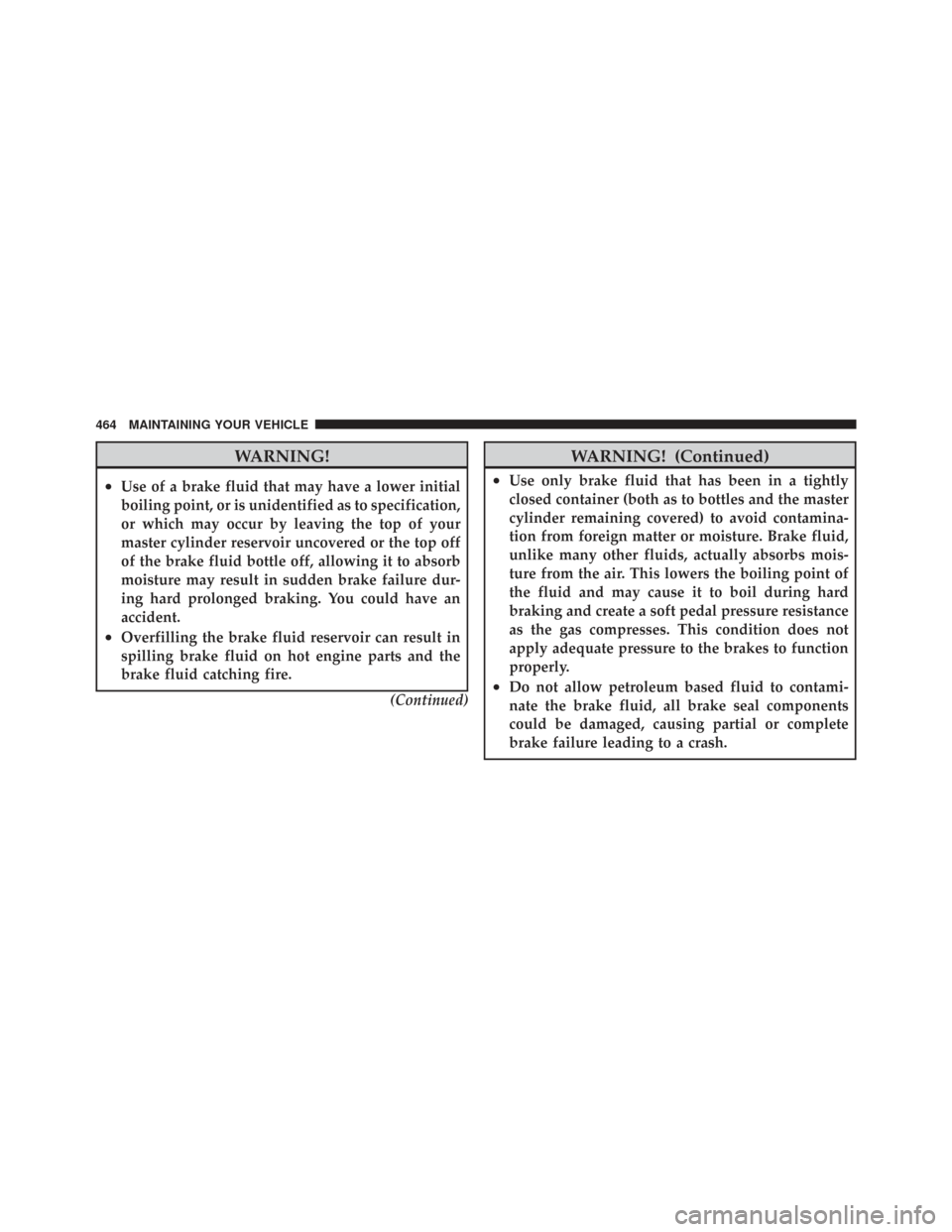
WARNING!
•Use of a brake fluid that may have a lower initial
boiling point, or is unidentified as to specification,
or which may occur by leaving the top of your
master cylinder reservoir uncovered or the top off
of the brake fluid bottle off, allowing it to absorb
moisture may result in sudden brake failure dur-
ing hard prolonged braking. You could have an
accident.
•Overfilling the brake fluid reservoir can result in
spilling brake fluid on hot engine parts and the
brake fluid catching fire.(Continued)
WARNING! (Continued)
•Use only brake fluid that has been in a tightly
closed container (both as to bottles and the master
cylinder remaining covered) to avoid contamina-
tion from foreign matter or moisture. Brake fluid,
unlike many other fluids, actually absorbs mois-
ture from the air. This lowers the boiling point of
the fluid and may cause it to boil during hard
braking and create a soft pedal pressure resistance
as the gas compresses. This condition does not
apply adequate pressure to the brakes to function
properly.
•Do not allow petroleum based fluid to contami-
nate the brake fluid, all brake seal components
could be damaged, causing partial or complete
brake failure leading to a crash.
464 MAINTAINING YOUR VEHICLE
Page 468 of 543
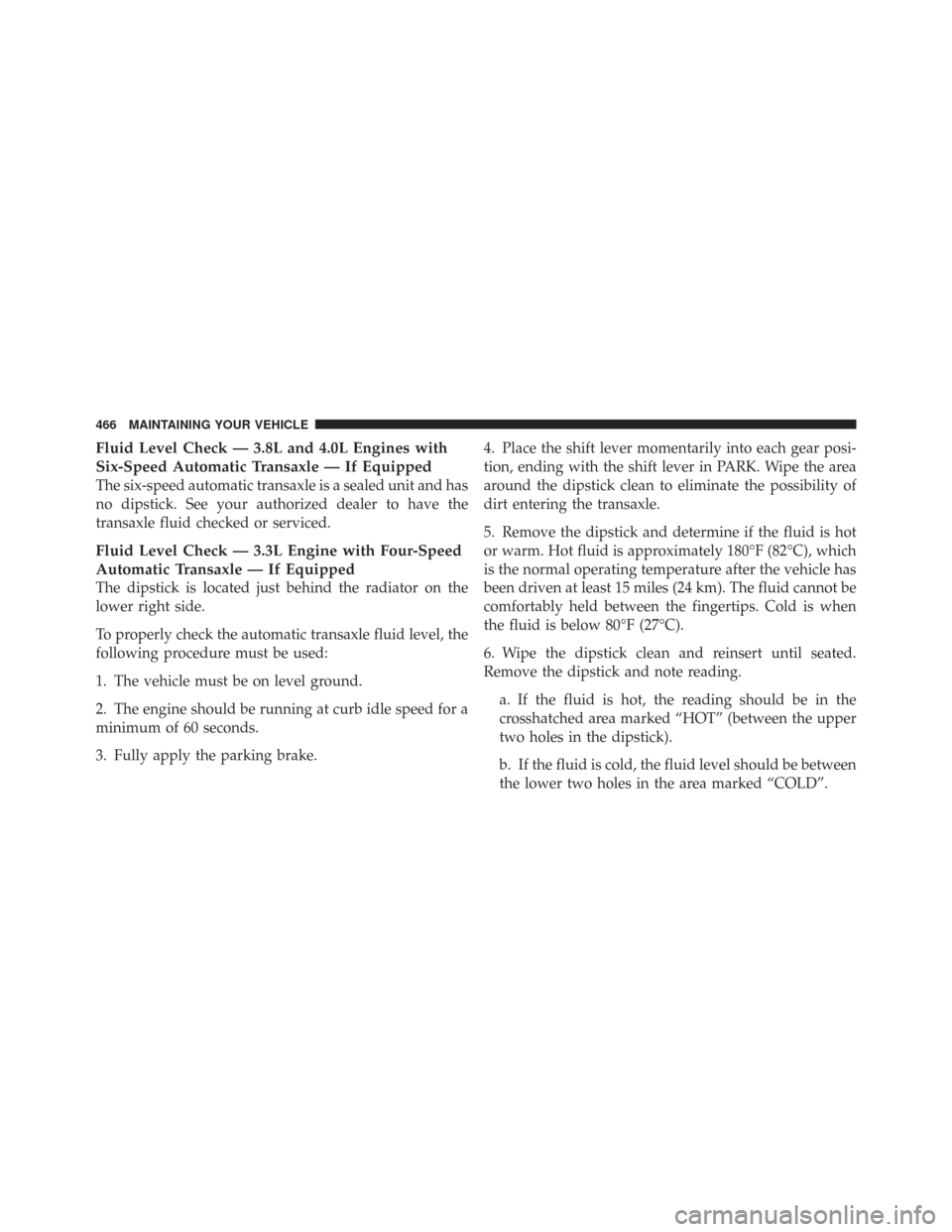
Fluid Level Check — 3.8L and 4.0L Engines with
Six-Speed Automatic Transaxle — If Equipped
The six-speed automatic transaxle is a sealed unit and has
no dipstick. See your authorized dealer to have the
transaxle fluid checked or serviced.
Fluid Level Check — 3.3L Engine with Four-Speed
Automatic Transaxle — If Equipped
The dipstick is located just behind the radiator on the
lower right side.
To properly check the automatic transaxle fluid level, the
following procedure must be used:
1. The vehicle must be on level ground.
2. The engine should be running at curb idle speed for a
minimum of 60 seconds.
3. Fully apply the parking brake.4. Place the shift lever momentarily into each gear posi-
tion, ending with the shift lever in PARK. Wipe the area
around the dipstick clean to eliminate the possibility of
dirt entering the transaxle.
5. Remove the dipstick and determine if the fluid is hot
or warm. Hot fluid is approximately 180°F (82°C), which
is the normal operating temperature after the vehicle has
been driven at least 15 miles (24 km). The fluid cannot be
comfortably held between the fingertips. Cold is when
the fluid is below 80°F (27°C).
6. Wipe the dipstick clean and reinsert until seated.
Remove the dipstick and note reading.
a. If the fluid is hot, the reading should be in the
crosshatched area marked “HOT” (between the upper
two holes in the dipstick).
b. If the fluid is cold, the fluid level should be between
the lower two holes in the area marked “COLD”.
466 MAINTAINING YOUR VEHICLE
Page 469 of 543
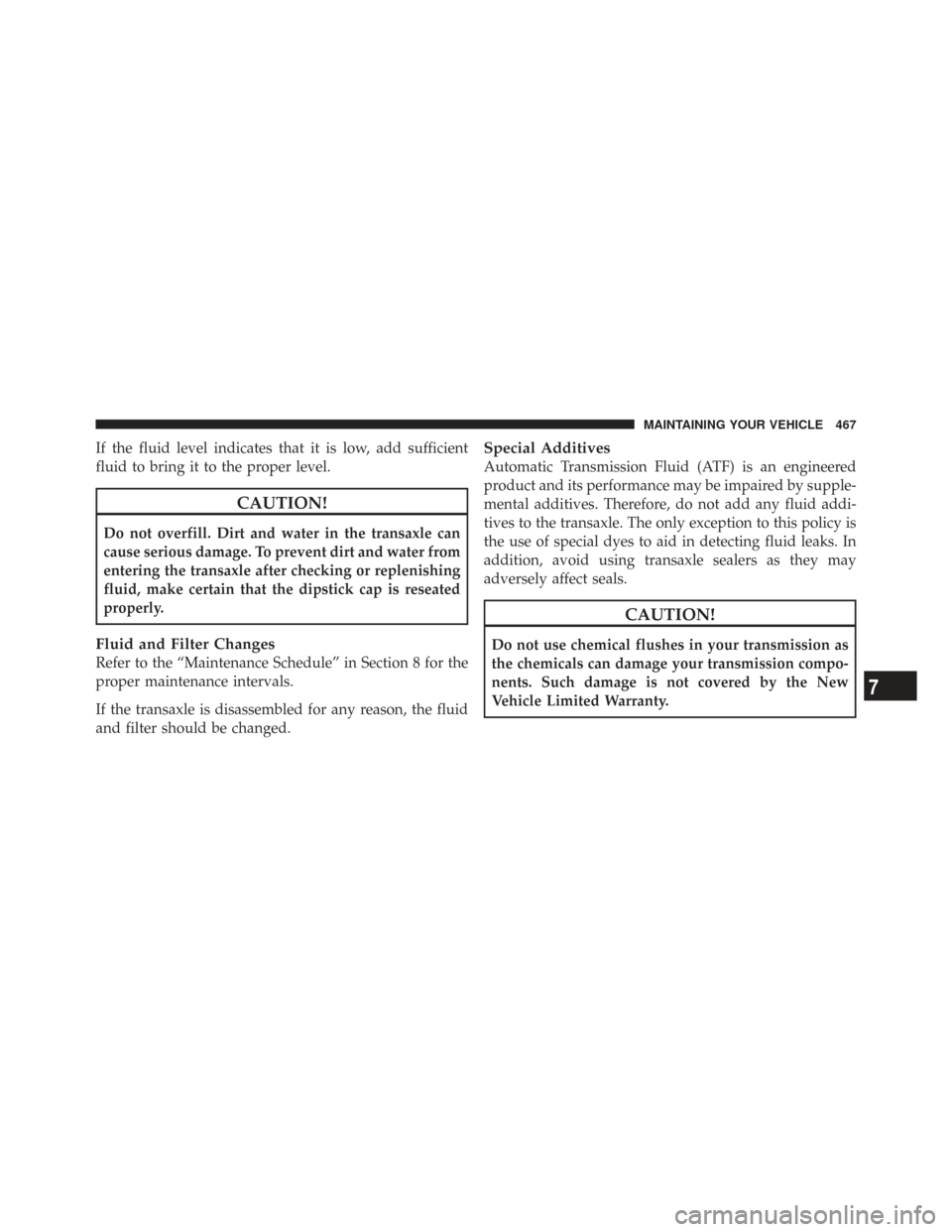
If the fluid level indicates that it is low, add sufficient
fluid to bring it to the proper level.
CAUTION!
Do not overfill. Dirt and water in the transaxle can
cause serious damage. To prevent dirt and water from
entering the transaxle after checking or replenishing
fluid, make certain that the dipstick cap is reseated
properly.
Fluid and Filter Changes
Refer to the “Maintenance Schedule” in Section 8 for the
proper maintenance intervals.
If the transaxle is disassembled for any reason, the fluid
and filter should be changed.
Special Additives
Automatic Transmission Fluid (ATF) is an engineered
product and its performance may be impaired by supple-
mental additives. Therefore, do not add any fluid addi-
tives to the transaxle. The only exception to this policy is
the use of special dyes to aid in detecting fluid leaks. In
addition, avoid using transaxle sealers as they may
adversely affect seals.
CAUTION!
Do not use chemical flushes in your transmission as
the chemicals can damage your transmission compo-
nents. Such damage is not covered by the New
Vehicle Limited Warranty.
7
MAINTAINING YOUR VEHICLE 467
Page 475 of 543
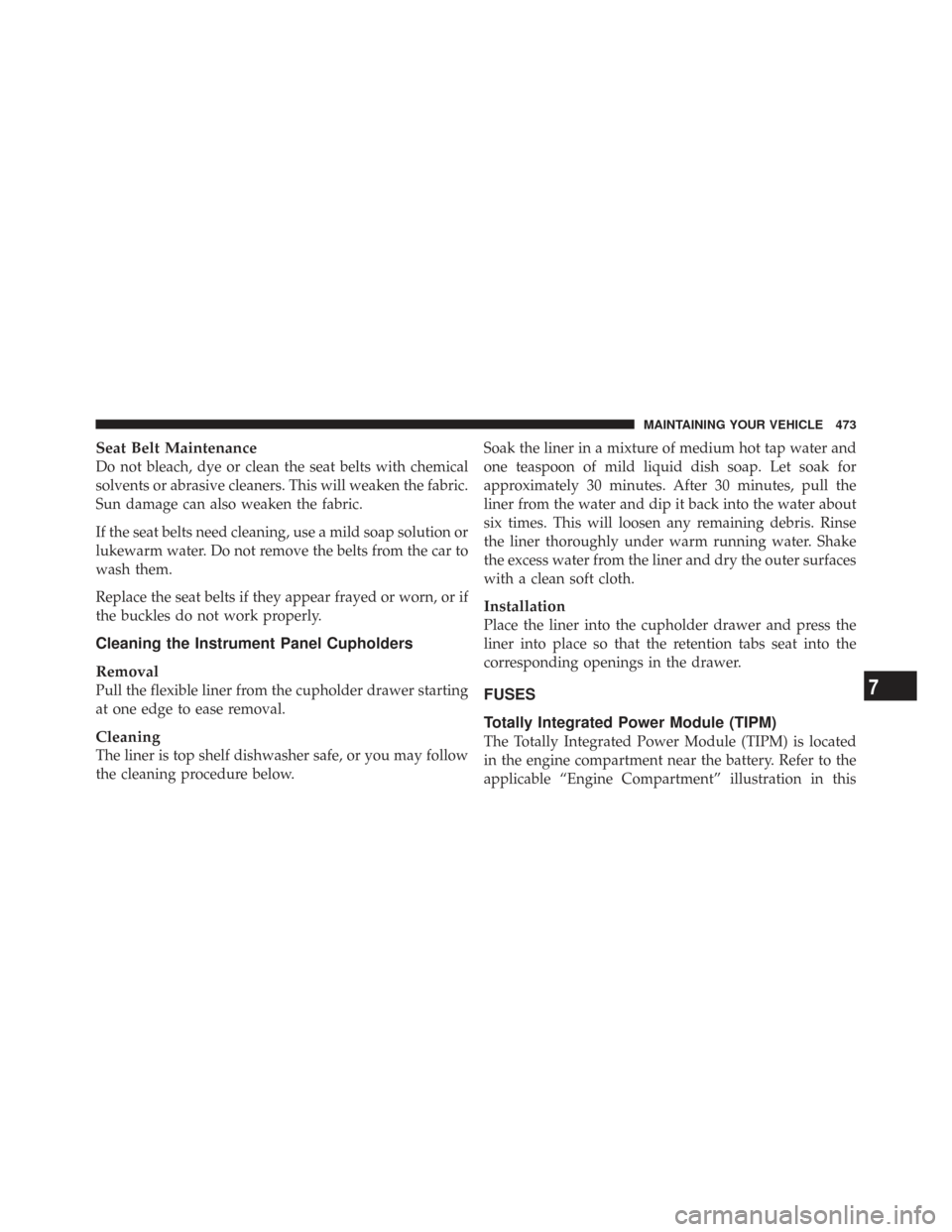
Seat Belt Maintenance
Do not bleach, dye or clean the seat belts with chemical
solvents or abrasive cleaners. This will weaken the fabric.
Sun damage can also weaken the fabric.
If the seat belts need cleaning, use a mild soap solution or
lukewarm water. Do not remove the belts from the car to
wash them.
Replace the seat belts if they appear frayed or worn, or if
the buckles do not work properly.
Cleaning the Instrument Panel Cupholders
Removal
Pull the flexible liner from the cupholder drawer starting
at one edge to ease removal.
Cleaning
The liner is top shelf dishwasher safe, or you may follow
the cleaning procedure below.Soak the liner in a mixture of medium hot tap water and
one teaspoon of mild liquid dish soap. Let soak for
approximately 30 minutes. After 30 minutes, pull the
liner from the water and dip it back into the water about
six times. This will loosen any remaining debris. Rinse
the liner thoroughly under warm running water. Shake
the excess water from the liner and dry the outer surfaces
with a clean soft cloth.
Installation
Place the liner into the cupholder drawer and press the
liner into place so that the retention tabs seat into the
corresponding openings in the drawer.
FUSES
Totally Integrated Power Module (TIPM)
The Totally Integrated Power Module (TIPM) is located
in the engine compartment near the battery. Refer to the
applicable “Engine Compartment” illustration in this
7
MAINTAINING YOUR VEHICLE 473
Page 482 of 543
FUSES/TIPM
Cavity Cartridge
Fuse Mini-
Fuse Description
M27 — 10 Amp RedIgnition Switch
(IGN SW), Window
Module (WIN
MOD), PEM, Steer-
ing Column Lock
M28 — 10 Amp RedNext Generation
Controller (NGC),
PCM, Transmission
Feed (TRANS
FEED), TCM
M29 — 10 Amp RedOccupant Classifi-
cation Module
(OCM)FUSES/TIPM
Cavity Cartridge
Fuse Mini-
Fuse Description
M30 — 15 Amp BlueRear Wiper Module
(RR WIPER MOD),
Power Folding Mir-
ror (PWR FOLD
MIR), J1962 Diag-
nostic Feed
M31 — 20 Amp YellowBack-Up Lamps
(B/U LAMPS)
M32 — 10 Amp RedOccupant Restraint
Controller (ORC),
TT EUROPE
M33 — 10 Amp RedNext Generation
Controller (NGC),
Global Powertrain
Engine Controller
(GPEC), TCM
480 MAINTAINING YOUR VEHICLE